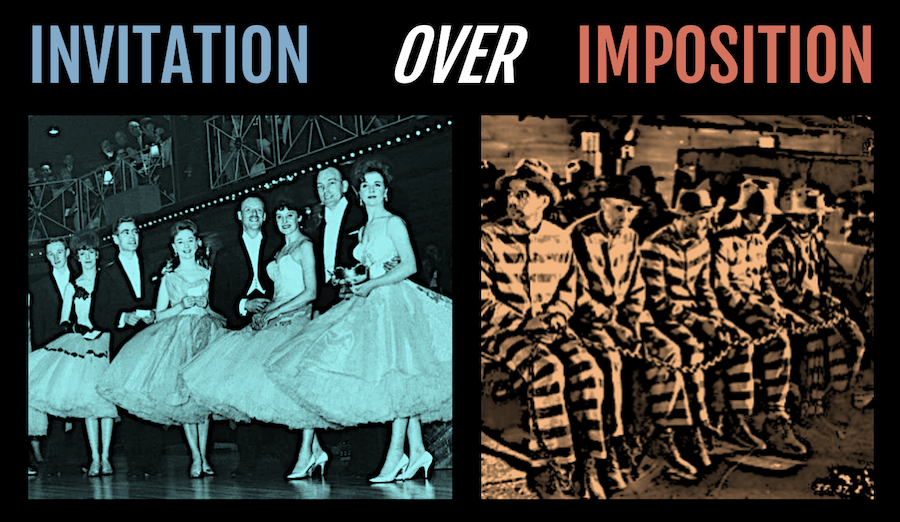
Invitation over Imposition
# Imposition
Agile imposition is when the decision to adopt Agile (**What**) is taken top-down without involving or consulting those affected. Or when the teams, regardless of their context, circumstances and personal preferences, are told which framework they have to adopt, including which tools and processes and practices (**How**). Or when the adoption is prescribed to be by the book, be it a given framework guide or a playbook (see for example Wiki Over Playbook), and is tested against a maturity model (see for example Self-Assessment Over Maturity Model). And the time and timeline are usually prescribed too (**When**).
Leaders responsible for the organisation's success may be advised that's the way to do it, or they may think it is the right way or may find it the only way available to them. Solutions depicted by scaled frameworks and large consultancy firms often lead to imposition too.
The reason why Agile imposition fails is that **learning cannot be conscripted**, it can only be volunteered. Furthermore, **Agile imposition prevents teams' autonomy** which is necessary for Agile to work as it needs teams to continuously autonomously adapt (their ways of working, processes, practices, tools, roles, governance, etc.) to fit their specific context and the changing circumstances.
**See also** – The Agile Imposition and the Agile Industrial Complex, Daniel Mezick: http://newtechusa.net/aic/ – The Agile Imposition Revisited: https://newtechusa.net/the-agile-imposition/ – Agile Imposition, Martin Fowler: https://www.martinfowler.com/bliki/AgileImposition.html – The State of Agile Software in 2018, Martin Fowler https://martinfowler.com/articles/agile-aus-2018.html
# Invitation
An invitation is when employees and teams are invited to participate in an Agile adoption (**What**) as an option they can choose or decline without being penalised. They are also invited to shape the Agile adoption that best fits their team's specific context and changeable circumstances (**How**). And they are allowed to do it at their own pace (**When**).
The optionality of the invitation reveals valuable information such as who feels ready and willing to pioneer the Agile adoption in the organisation. Starting small with the volunteers will accelerate learning. And the initial successes will pave the way for others to join the party. This need for actual success also keeps the initiative honest and focuses the effort on what really matters.
The role of the leaders in facilitating the success of such Agile adoption is to create an environment that is favourable to modern ways of working gradually shifting the organisation structure, governance, and incentives around the teams that are volunteering and supporting them removing the other obstacles surfaces. The leaders also need to steer the hiring to attract talent with the experience and cultural fit for the new Agile organisation.
The paradigm of Invitation is also deeply embedded in the adaptive Agile ways of working more than the eyes meet, to the point that approaching an Agile adoption using Invitation is a way of **being Agile in adopting Agile**. When, for example, an organisation is dealing with a piece of work with some novelty, uncertainties, unknowns and change, the agreement (contract) between the team and the customer, the expectations of the stakeholders on the team, the way the risk is managed, the way the team and the stakeholders and the customers set the priorities and approach the work gradually and iteratively, all are very congruent with the paradigm of Invitation.
**See also** – Invitation-based leadership, Daniel Mezick: https://invitingleadership.com/ – Promise Theory, by Mark Burgess: http://markburgess.org/promises.html